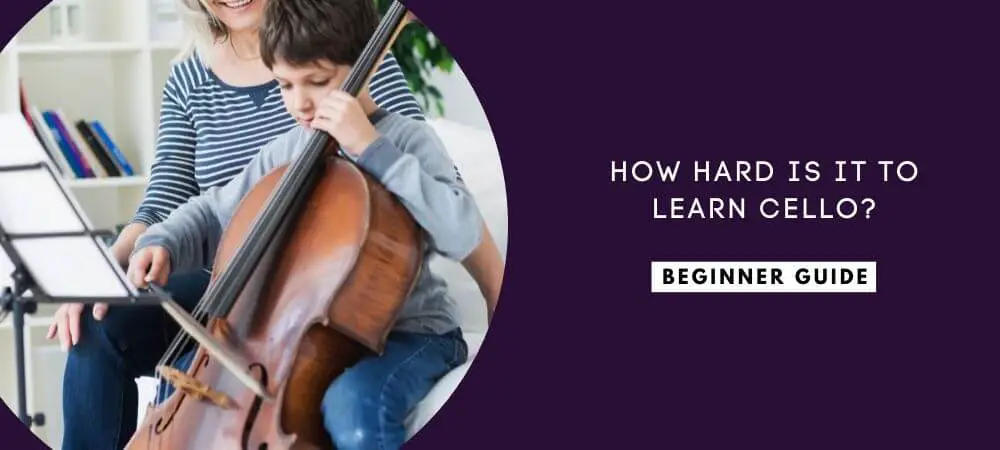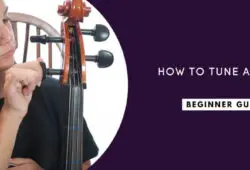Anyone learning cello for the first time often longs for the day when they can play a single note without it scratching, playing out of tune, or hitting other strings.
Add the pressure of bowing properly, and it can seem nearly impossible to play the cello with any kind of proficiency.
Really, how hard is it to learn cello?
It can be challenging, but the process could be much more streamlined and less of a hassle with a few tips and tricks outlined herein.
Table of Contents
Quick Summary
- Learning cello fundamentals might seem relatively easy, but mastering the instrument is where the true challenge lies.
- Getting a naturally comfortable bow hold takes time, and in a bid to attain this, you will end up modifying your bow hold countless times throughout your cello playing.
- It can take years to learn how to add vibrato correctly, and yet this vital technique is what truly makes cello music sing out.
Is Cello Hard To Learn?
Yes, the cello is pretty hard to learn.
Here’s the thing: grasping the fundamentals of cello playing is relatively easy. These basics involve holding the instrument, holding the bow, producing sound by bowing a straight bow across the strings, etc.
However, the challenging part is how to apply this knowledge, efficiently turning it into a proficient skill. Mastering the cello involves plenty of learning, unlearning, and relearning, and this entire process requires a great deal of commitment and focus to keep you on track.
Let’s delve a little deeper into the various aspects that make cello hard to learn, shall we?
1. Intonation
One of the greatest challenges when playing string instruments is obtaining and maintaining pitch accuracy in all positions.
Unlike the piano, the cello doesn’t have any fixed keys to determine the pitch. Additionally, every single note on the cello can be phrased differently, which, once again, isn’t a challenge you encounter while playing tempered instruments such as the piano.
As a result, it is incredibly difficult to play the cello in tune. The intonation is wide open, and so to be in tune, the cellist is required to adjust notes relative to one another.
2. Fretless
The frets on a guitar help guide the player to physically locate each note on the fingerboard. This makes the instrument easier to master because to produce the note you want to hear, you simply place your finger on the right fret.
On the other hand, the cello is fretless, so there aren’t any guides to help you find notes. Similarly, there aren’t any keys or valves either.
Instead, the cellist has to rely on certain fingerboard-mapping techniques and 3D muscle memory to remember the location of each note on the fingerboard.
Playing different notes calls for specific arm lengths and hand shapes to guide your hand position, and this is what the player ends up memorizing with time.
Needless to say, developing this muscle memory takes a long time, requiring consistent daily practice over a considerable period.
3. Ear Training
Some people are born with perfect pitch, whereby they bear a natural ability to hear a note and can instantly tell what it is, accurately identifying it by name.
Not everyone is that lucky. For most people, ear training is something they have to work on consistently and conscientiously.
However, the good news is that it is possible to acquire this skill. After years of practice and experience, you will find that your ears open up in new ways so you can better hear nuances in tone.
Without any visual or mechanical references to help you locate notes on the fingerboard, cellists are as dependent on their aural skills as singers are. Professional cellists will tell you that the ability to sing your cello parts will prove invaluable, and the sooner you can do it, the better off you will be.
Ideally, this means that you have to use your ‘inner ear’ to imagine the note’s pitch before you play it.
Even with muscle memory and fingerboard mapping techniques, aural skills are still required because the inner ear will always relate one note to a previously-sounded one. This then brings about the concept of interval recognition.
4. Interval Recognition
Music intervals form the fundamental basis for all ear training concerning pitch.
Simply put, an interval is the distance between any two notes, and you can have semitones, tones, thirds, fourths, etc.
The melodic ear requires horizontal hearing, whereby you are playing only one note at a time sequentially. The harmonic ear requires vertical hearing whereby you are playing simultaneously, one note on top of the other.
To sound good on the cello, players need to become perfectly accustomed to the different fingerings and manifestations of common interval and interval patterns. This means that you will be required to recognize types of scales, chords, and chord progressions.
5. Bowing
Bowing is difficult, incredibly difficult.
For many players, this is the one aspect of playing cello that they struggle getting their head around because it is like dealing with a whole other instrument altogether.
The first challenge is holding the bow comfortably such that you feel completely in control but without getting so tensed up that your muscles become sore from the bow hold.
The next one is learning how to draw a straight bow across each string while producing a nice even sound throughout that doesn’t diminish towards the tip.
Bowing requires you to do so without screeching, sliding, or gliding across the strings, and this is not only about bowing technique but about how you rosin your bow as well.
Bow speed is the other aspect whereby varying it will allow you to create different styles for either more or less core and resonance.
Correct bow placement on the open strings requires learning how to handle and tip the bow accordingly, relative to the cello’s strings.
Not to mention that the cello is more expressive than most other instruments, and different bowing styles will give you a different feel.
6. Bowing-Fingering Coordination
While playing the cello, think of it like this: the bow is for talking, while the left-hand picks and fingers the words. These two elements need to work together seamlessly and effortlessly while maintaining the correct intonation.
Bowing is difficult. The left-hand technique is equally as difficult. Doing both, at the same time, requires great skill, mastery, and patience.
How Long Does It Take To Learn The Cello?
Before discussing how long it takes to learn the cello, I will start by saying that it is not an instrument of instant gratification. Also, your playing proficiency will be directly related to the amount of quality time you are putting into your practice sessions.
The recommendation is to dedicate between 30-60 minutes of focused practice time, every day, for 5-6 days a week.
If you follow this schedule, you should play simple melodies fairly competently in a couple of months.
After a year or so, you should have an expanding repertoire of simple material. Still, it won’t be until the 2-year mark before you can sound pretty good on the cello, to the point where you can even join a local amateur orchestra.
Of course, this is not a hard and fast rule because certain variables will have to be considered. These include:
- Age: learning processes are different at different ages.
- Teaching Method: are you self-teaching, taking online lessons, or have a good teacher?
- Musical Experience: do you have experience playing other instruments in the string family?
- Music Theory: do you have experience with reading sheet music?
- Aspirations: do you desire to merely understand the basics or play fluently?
- Practice Time: how much time are you putting into practicing playing the cello?
Of all these variables, perhaps the greatest one of all is practice time. A cello beginner will have to put in steady, dedicated daily practice time to play cello even fairly well. There is just no shortcut around this.
Another thing worth pointing out is that there is never an end to learning a musical instrument. There is always something new to learn, experiment with, and something to improve on.
Playing cello at an expert level won’t come easy because this is one instrument that takes a really long time to master. However, the rush of excitement within you every time you notice even the slightest improvement is completely unmatched, and that’s what keeps many beginning musicians going.
Tips To Make Learning Cello Easier For You
a) Correct cello sizing
The right cello size for your age, height, and arm measurement will provide the best fit for ultimate comfort while holding and playing the instrument.
b) Learn to tune the instrument
Struggling to play an instrument that is out of tune will only make your learning process that much harder and far less enjoyable.
Often, beginning musicians wonder why their instrument gets out of tune so often. This is to be expected, especially with changes in humidity and temperature. So whether or not you have someone who can tune your instrument for you, it would be better to learn how to do it yourself.
c) Rosin the bow properly
Too much rosin will give your bow too much grip, whereas too little rosin will have the bow sliding off the strings.
To produce decent sound from a cello, your bowing needs to be effortless, and rosin plays an important part in ensuring this.
d) Warm-up before playing
Playing cello is physically tasking, so you need to perform warm-up exercises for your arms, fingers, and neck before you start each cello playing session.
Failure to do so will result in an overuse injury, some of which can be lasting.
e) Learn music theory
Most cello music is written down, as opposed to being transferred aurally. As a result, having the ability to read music by reading notes and rhythms will give you an advantage.
Cello music is primarily written in the bass clef. However, the treble clef may also be used if the desired notes are of a particularly high pitch. The tenor clef typically features in orchestral music.
f) Scale practice
Regularly practicing scales and strings will help with ear training.
g) Get a good teacher
Having the right instructor will prove an invaluable investment, helping you learn the right technique right from the get-go. Additionally, your playing will even progress faster due to the lessons designed to keep you on track.
FAQs About How Hard Is It To Learn Cello
Is Cello Harder Than Guitar?
Yes, cello is harder than guitar.
A person who’s played guitar knows that it is a little easier to grasp in that producing a note is as straightforward as placing your finger on the right fret.
Furthermore, the guitar isn’t governed by the strict rules that govern cello playing, that is, playing posture, techniques, tuning the instrument, etc.
Can You Teach Yourself Cello?
Yes, you can teach yourself cello using books and online lessons.
That being said, self-teaching cello isn’t advisable because you could easily pick up bad habits relating to posture and technique, and these will be very difficult to rectify later on.
Can Adults Learn Cello?
Yes, adults can learn cello.
Adult beginners actually have certain advantages over younger players. Firstly, they can coordinate their bodies much better than those of a young age. This means that adult learners can grasp the correct posture and technique faster than younger learners.
Commitment is the other aspect whereby adults are more certain about why they wish to learn an instrument. So they will be better self-motivated to stick to it, putting in the required practice time without fail.
How Many Hours Does It Take To Learn The Cello?
It will take about 350 hours of steady, dedicated daily practice time to have you sounding pretty good on the cello.
Broken down, this translates into 30 minutes of focused practice time, every single day, six days a week, for about 2 years.
Conclusion
Mastering the cello means that you will no longer be grappling with technique or finding yourself feeling limited by the constraints of the instrument.
Getting here might seem like a dream, but all it requires is plenty of hard work, persistence, dedication, and focused daily practice time. As long as you put in the hard work, the results will be evident in your improved playing.
Ultimately, just have fun with it and allow you to express yourself fully.





